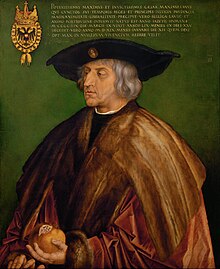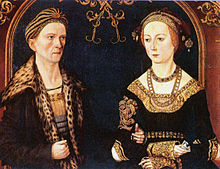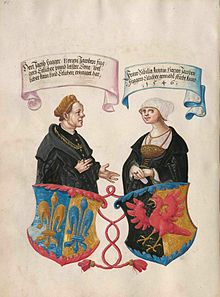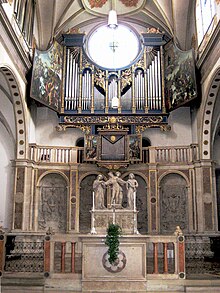Jakob Fugger
Jakob Fugger | |
|---|---|
Augsburg, Holy Roman Empire | |
| Died | 30 December 1525 (aged 66) Augsburg, Holy Roman Empire |
| Resting place | St. Anna's Church |
| Spouse |
Sybilla Artzt (m. 1498) |
| Parents |
|
| Relatives | Anton Fugger (nephew) |

Jakob Fugger of the Lily (
The foundation of the family's wealth was created mainly by the textile trade with Italy. The company grew rapidly after the brothers Ulrich, Georg and Jakob began banking transactions with the House of Habsburg as well as the Roman Curia, and at the same time began mining operations in Tyrol, and from 1493 on the extraction of silver, and copper in the kingdoms of Bohemia and Hungary. As of 1525 they also had the right to mine quicksilver and cinnabar in Almadén.
After 1487, Jakob Fugger was the de facto head of the Fugger business operations which soon had an almost monopolistic hold on the European copper market.[3] Copper from Hungary was transported through Antwerp to Lisbon, and from there shipped to India. Jakob Fugger also contributed to the first and only trade expedition to India that German merchants cooperated in, a Portuguese fleet to the Indian west coast (1505–1506), as well as a failed 1525 Spanish trade expedition to the Maluku Islands.
With his support of the
Jakob Fugger secured his legacy and lasting fame through his foundations in Augsburg. A chapel funded by him and built from 1509 to 1512 is Germany's first renaissance building and contains the tombs of the brothers Ulrich, Georg and Jakob. The Fuggerei which was founded by Jakob in 1521 is the world's oldest social housing complex still in use. The Damenhof, part of the Fuggerhäuser in Augsburg, is the first secular renaissance building in Germany and was built in 1515.
At his death on 30 December 1525, Jakob Fugger bequeathed to his nephew
Life
Background, education and early years in Venice

Jakob Fugger was born the tenth of eleven children to
Jakob's older brothers Ulrich (1441–1510) and Georg (1453–1506) created the basis for the rise of the company in Europe. Around 1470 they founded manufactories in Venice and Nuremberg, then important centers of trade. Jakob Fugger's brothers Andreas and Hans both died young in Venice. His brother Markus was a cleric and from 1470 on a writer in a papal chancery in Rome where he died in 1478. His brother Peter died in an epidemic in Nuremberg in 1473.[7][8]
Loans given to Emperor Frederick III and supplies given to his entourage by Ulrich Fugger were the reason for the family being granted the lily coat of arms in 1473.[9] The "of the lily" (German: von der Lilie) naming after this coat of arms distinguishes this line of the Fugger family from the "of the doe" (German: vom Reh) branch.
Until 2009 historians assumed that Jakob Fugger, who was a
Beginnings of the mining and metal trade

Jakob Fugger laid the foundation of his mining business in Salzburg. He provided loans to the independent silver mine owners in the Salzburg Slate Alps which had constant need for new capital. Instead of receiving the usual documents acknowledging debt, he demanded "Kuxe", which essentially made him a shareholder in the mines. Through this he forced more and more mine operators in the area of Gastein and Schladming to sell their silver directly to the Fugger family instead of intermediary traders.[12]
Jakob Fugger was responsible for his family's business in Augsburg,
Relationship with Maximilian I

The expansion of high-risk, albeit very lucrative business connections to Maximilian I was undoubtedly promoted by Jakob. In his view, the House of Habsburg was bound to be the dominant power and dynasty within the German region, and as such should receive his financial and political support. Jakob Fugger met the young Roman-German king for the first time in 1489 at a Frankfurt fair. At that time, his plans for the independent Duchy of Tyrol had been agreed upon with the king's chancellor, Johann Waldner. On 16 March 1490 Sigismund and the Tyrol Estates came together with King Maximilian also present. The archduke had to resign under the pressure from the estates, who accused him of mismanagement, and his possessions fell to the king. Maximilian then promised to repay all loans of its predecessor to Jakob Fugger.[15]
Thus the Fugger business became one of the most important financial backers of Maximilian, who since 1486 was co-regent of the
On 15 July 1507 Maximilian I sold the County of
Criticism from reformer
Much later the Fugger family lost a large portion of their wealth following three Spanish state bankruptcies (1557, 1560, 1575) under the reign of Philip II of Spain.[21][22]
Mining and metal trade

Likely at the insistence of Jakob Fugger the company became one of the first open trading companies (German: "der compagnia palese des welschen Rechts")[23] in Europe in 1494. At the same time, it was renamed into "Ulrich Fugger of Augsburg and brothers" to show the equality of the three brothers involved in business issues, even though Tyrolean sources almost universally speak of the Jakob Fugger company and central contracts of the Hungarian trade were all signed by him. At this development the greatly increased influence of Jakob within the company can be observed. During the late 1480s Jakob Fugger dominated the company's policies, although the eldest brother Ulrich still formally led the company.[24]
The enormous growth potential in the
The Vatican as a client

The Fugger family were the first German trading house in a direct business relationship with the Roman Curia.
Overseas trade
The commodity trade played a relatively small role compared to the two main branches of the Fugger business, banking and mining. It is only because of the associated exotic investments that Jakob Fugger's early trading expeditions take a prominent place in the history of the Fugger business.
After
Unlike the
The great crisis of Jakob Fugger
Especially for mining projects in
Since the death of his brothers Georg in 1506 and Ulrich in 1510, Jakob Fugger was now running the Fugger business as the sole policy and decision maker. The company was renamed into "Jakob Fugger und Gebrüder Söhne" (Jakob Fugger and Brother's Sons). In the following years up until his death Jakob Fugger managed to raise the family fortune which amounted to about 200,000 guilders in 1511 to more than 2,000,000 guilders, perhaps 2% of Europe's GDP.[38]
Election of Charles V in 1519

This was a difficult situation for Charles who now relied on the riches of Jakob Fugger to sway the election in his favor. Fugger transferred the enormous sum of more than 850,000 guilders to the Prince-electors which ultimately resulted in the unanimous election of Charles Holy Roman Emperor on 28 July 1519. Out of this 850,000 guilders Fugger himself funded around 550,000 while another merchant house of Augsburg, the Welser family, contributed about 150,000 and three Italian bankers providing the rest. What today would be seen as bribery was common practice in the election of the Emperor. Exceptional however were the immense sums involved, mainly due to the keen competition among the princely candidates.[39]
A few days later the Pope granted Charles the right to name himself Elected Emperor. It was only in 1530 that Charles V was crowned Emperor by the Pope in Bologna. He was the last Emperor to receive a papal coronation.[40] Charles V, since his election reigning over a realm where the sun never set, was now deeply indebted to Jakob Fugger. In 1521 the debts amounted to more than 600,000 guilders. The Emperor amortized 415,000 of this sum and in return granted the Fugger company the silver and copper mining operations of Tyrol.[34] During the Imperial Diet of 1523 in Nuremberg it was debated whether to restrict trade capital and the number of trade establishments companies were allowed to maintain. Jakob Fugger intervened and reminded the Emperor that "It is known that your imperial majesty could not have claimed the Roman crown without my help,..." (German: „Es ist auch wissentlich und liegt am Tage, dass Eure Kaiserliche Majestät die römische Krone ohne mein Zutun nicht hätte erlangen können,…")[41] The added demand of repayment of all debts eventually led to all discussions of trade restrictions and limits to monopolies being dropped. In addition to this Jakob Fugger was granted a concession to mine quicksilver and cinnabar in Almadén. The Fugger company was involved in the Spanish mining business up to the year 1645.[42]
Marriage, heritage and successors


In 1498 the 40-year-old Jakob Fugger married Sybille Arzt (also: Artzt) Grand Burgheress of
Jakob Fugger died on 30 December 1525. The inventory performed by his heirs revealed assets totaling 3,000,058 guilders and liabilities amounting to 867,797 guilders resulting in a surplus of 2,132,261 guilders.[45]
Because he had no direct descendants, the company and its assets were bequeathed to his nephews Raymund and Anton Fugger, who also led the company. Anton managed to double the family's fortune once more by 1546.[46]
Religious views and Reformation
Jakob was a lifelong
The citizens of
Only a few years after Jacob Fugger's death the Augsburg Confession by Philip Melanchthon was formulated at the Diet of Augsburg in 1530. The Confessio Augustana represents the confessional and founding document of the Lutheran Church. The descendants of Jacob Fugger have remained Catholic to this day.
Foundations and buildings of Jakob Fugger
Fugger chapel in the Annakirche

Together with his brother Ulrich and on behalf of his deceased brother Georg, Jakob Fugger founded the Fugger chapel in the Carmelite monastery's St. Anna church located in Augsburg. It became the burial place of the three brothers and the two nephews Raymund Fugger and Hieronymus Fugger (1499–1538).
Construction began in 1509 and was finished in 1512. The chapel was modeled after Italian burial chapels with clear influences out of Venice and Rome, thereby becoming Germany's first renaissance construction. The interior was designed with the help of many notable German artists of the time, such as Albrecht Dürer, Hans Burgkmair, Jörg Breu the Elder and Hans Daucher. The building is thought to have been built in preparation for Fugger's elevation into nobility and to distance himself from the local Patricians. Furthermore, it was a medium to preserve the name and memory of Fugger in the style of the Italian "Memoria" architecture.[52]
In 1518 the chapel was consecrated to the patron saint of Jesus Christ in the altar sacrament, the Holy Virgin Mary and the Evangelist Matthew and has remained a consecrated Catholic place of worship to this day. When St. Anne's Church became Protestant in 1548, the Fugger Chapel remained Catholic because the Fugger Foundation continued to look after it and contributed to the upkeep of the church. This is how the remarkable fact came about that part of the church is denominationally different from the rest, and that the burial place of the Fugger family, who are considered strictly Catholic, is now in a Protestant church.[53]
Fuggerhäuser in Augsburg

The Fugger family already owned two houses in Augsburg in prominent locations when Jakob Fugger built the Fuggerhäuser near the wine-market (now Maximilianstraße) from 1512 to 1515. The Builder of this Residence was most likely Hans Hiebe. Inside the Fuggerhäuser, the Damenhof (Ladies courtyard) was modeled after the florencian style grand courtyards, thus becoming Germany's first secular renaissance building. The complex was expanded once more in 1523 to accommodate the receiving of illustrious guests. The Fuggerhäuser were the private residence and administrative center of Jakob Fugger and his wife Sybille Fugger-Arzt.[54]
Later members of the Fugger family enlarged the complex several times. The complex was mostly destroyed during air raids on Augsburg in World War II and rebuilt in a simplified way in 1955. The courtyards and several other rooms however are still in their original state. The houses are still owned by the Fugger family, partly being used to house the Fürst Fugger Privatbank.
St.-Moritz-Prädikatur-Stiftung
In 1515 Jakob Fugger advocated for an improved sermon in the church of his parish
Fuggerei

Beginning in 1516 Jakob Fugger funded the construction of a settlement for craftsmen and day laborers in need. In 1523, 52 houses of the estate were built. It was first named Fuggerei in 1531. Originally it was meant to house people who were in a difficult situation through no fault of their own until they could establish a stable household on their own. The yearly rent was one symbolic guilder, though additionally requested were three daily prayers in the name of Fugger and his family.
The settlement was expanded several times, lastly in 1973. About 150 people live in the Fuggerei today, still paying an annual rent of the equivalent of one guilder (0.88 €). The Fuggerei is a major tourist attraction of Augsburg and since 2006 also houses a museum. The settlement is still administered by the descendants of the Fugger family and financed through a foundation (originally from 1521).
Other foundations and buildings
Jakob Fugger made several contributions to churches and monasteries in Augsburg some of which still show the Fugger family's coat of arms. He funded the church San Blas in Almagro, Spain and the reconstruction of the Santa Maria dell'Anima in Rome.[55] He also built a chapel in Oberkirchberg as well as building a palace in Weißenhorn.[18]
Literature
Academic
- Bruno Bushart: Die Fuggerkapelle bei St. Anna in Augsburg, Munich 1994, ISBN 978-3-422-06115-6.
- Richard Ehrenberg: Das Zeitalter der Fugger, Geldkapital und Creditverkehr im 16. Jahrhundert (2 Vol), Jena 1896.
- Peter Geffcken: Jakob Fuggers frühe Jahre. In: Martin Kluger (Augsburg): Jakob Fugger (1459–1525). Sein Leben in Bildern, context medien und verlag, Augsburg 2009, ISBN 978-3-939645-14-6.
- Peter Geffcken: Jakob Fugger der Reiche (1459–1525): "Königsmacher", Stratege und Organisator". in: DAMALS 7/2004.
- Peter Geffcken: Fugger – Geschichte einer Familie: "Die Handelsherren mit dem Dreizack". in: DAMALS 7/2004.
- Mark Häberlein: Die Fugger. Geschichte einer Augsburger Familie (1367–1650), ISBN 978-3-17-018472-5.
- Sarah Hadry: Die Fugger in Kirchberg und Weißenhorn. Herrschaftsverfassung und Leibeigenschaft, Konfessionalisierung und Residenzbildung, Wißner, Augsburg 2007, ISBN 978-3-89639-613-6.
- Max Jansen: Die Anfänge der Fugger, Leipzig 1907, ISBN 978-3-86741-614-6.
- Peter Kalus: Die Fugger in der Slowakei, Augsburg 1999, ISBN 978-3-89639-175-9.
- Franz Karg: Eines Stadtherren Profil. Jakob der Reiche, der erste Fugger in Weißenhorn, in: Weißenhorner Profile 1160–2010. Beiträge und Untersuchungen zur Stadtgeschichte (Kataloge und Schriften des Weißenhorner Heimatmuseums 5), Weißenhorn 2010.
- Hermann Kellenbenz: Die Fugger in Spanien und Portugal bis 1560. Ein Großunternehmen des 16. Jahrhunderts (2 Vol), Munich 1990, ISBN 978-3-925355-60-8.
- Norbert Lieb: Die Fugger und die Kunst. Band 1: Im Zeitalter der Spätgotik und der frühen Renaissance, Munich 1952.
- Götz von Pölnitz: Jakob Fugger, in: NDB, Neue Deutsche Biographie, 5. Bd. (1961), S. 710–716.
- Götz von Pölnitz: Die Fugger. Mohr & Siebeck, 6. Aufl. Tübingen 1999, ISBN 3-16-147013-3.
- Götz von Pölnitz: Jakob Fugger. Mohr & Siebeck, Tübingen 1949. Preview: Jakob Fugger, Quellen und Erläuterungen.
- Benjamin Scheller: Memoria an der Zeitenwende. Die Stiftungen Jakob Fuggers des Reichen vor und während der Reformation (ca. 1505–1555), Berlin 2004, ISBN 978-3-05-004095-0.
- Aloys Schulte: Die Fugger in Rom 1495–1523 (2 Vol), Leipzig 1904, ISBN 978-5-87416-398-3.
- Marion Tietz-Strödel: Die Fuggerei in Augsburg, Tübingen 1982, ISBN 978-3-16-844570-8.
- Eike Eberhard Unger: Die Fugger in Hall i. T., Tübingen 1967, ASIN B0000BTV29.
- Jacob Strieder: Jacob Fugger the Rich, Washington 1931, ISBN 978-1-163-18704-3.
- Barbara Günther: Sybille Fugger, die Frau Jakobs des Reichen., 1985, ISBN 3-7987-0235-7
Popular
- Franz Herre: Die Fugger in ihrer Zeit. Wißner-Verlag, 12. Auflage, Augsburg 2005, ISBN 3-89639-490-8.
- Tanja Kinkel: "Die Puppenspieler". München 1993
- Martin Kluger: Die Fugger in Augsburg. Kaufherrn, Stifter und Mäzene, context verlag, Augsburg 2010, ISBN 978-3-939645-31-3.
- Martin Kluger: Die Fugger: Die deutschen Medici in und um Augsburg, context verlag, Augsburg 2009, ISBN 978-3-939645-13-9.
- Martin Kluger: "Jakob Fugger (1459–1525). Sein Leben in Bildern", context medien und verlag, Augsburg 2009, ISBN 978-3-939645-14-6
- Martin Kluger: Die Fuggerei. Ein Führer durch die älteste Sozialsiedlung der Welt. context-verlag, Augsburg 2009, ISBN 978-3-939645-16-0
- Martin Kluger: Fugger – Italien. Geschäfte, Hochzeiten, Wissen und Kunst. Geschichte einer fruchtbaren Beziehung, context medien und verlag, Augsburg 2010, ISBN 978-3-939645-27-6.
- Martin Kluger: The Fugger Dynasty in Augsburg. Merchants, Mining Entrepreneurs, Bankers and Benefactors. context verlag Augsburg, Augsburg 2014, ISBN 978-3-939645-74-0.
- Günter Ogger: Kauf dir einen Kaiser. Die Geschichte der Fugger. Droemer Knaur, 17. Auflage, Munich 1995, ISBN 3-426-03613-4.
- ISBN 978-1-451-68855-9
In fiction
- Peter Dempf: Das Amulett der Fuggerin BLT, Bergisch-Gladbach 2006, ISBN 978-3-404-92273-4.
- ISBN 978-3-8392-1144-1.
- Patrick O'Brian: "The Thirteen Gun Salute" Collins (UK) 1989, ISBN 0-00-223460-2.
- ISBN 978-00-62409-16-4.
Family tree
References
- ^ Steinmetz, Greg. "Opinion: 7 money-making lessons from the richest man who ever lived". MarketWatch. Retrieved 21 May 2021.
- ^ Greg Steinmetz, The Richest Man Who Ever Lived: The Life and Times of Jacob Fugger, Simon & Schuster 2015, p. xiv
- ^ Peter Geffcken: Fugger – Geschichte einer Familie: "Die Handelsherren mit dem Dreizack" [Fugger: History of a family: The merchants with the trident]. In: DAMALS 7/2004
- ^ "Anton Fugger". Encyclopædia Britannica.
- ^ "Jakob Fugger". The Wall Street Journal.
- ^ Häberlein 2006, pp. 20–22
- ^ Pölnitz 1999, pp. 44–46
- ^ Häberlein 2006, pp. 34–35
- ^ Häberlein 2006, p. 26
- ^ Geffcken 2009, p. 15
- ^ Pölnitz 2009, pp. 32–33
- ^ Strieder 1931, pp. 110–12
- ^ a.s, Petit Press (8 July 2002). "Mineral and political wealth of Banská Bystrica mining region has flown". spectator.sme.sk.
- ^ Eike Eberhard Unger: Die Fugger in Hall i.T., Tübingen 1967
- ^ Pölnitz 1999, p. 60
- ^ "Luminarium Encyclopedia: Maximilian I, Holy Roman Emperor". www.luminarium.org.
- ^ Sarah Hadry: Die Fugger in Kirchberg und Weißenhorn. Herrschaftsverfassung und Leibeigenschaft, Konfessionalisierung und Residenzbildung, Augsburg 2007
- ^ a b c Häberlein 2006, p. 188
- ^ Pölnitz 1999, p. 112
- ^ Mark Häberlein: Die Fugger. Geschichte einer Augsburger Familie (1367–1650), Stuttgart 2006
- ^ Häberlein 2006, p. 101
- ^ Pölnitz 1999, p. 255
- ^ "Jahresberichte für Deutsche Geschichte". pom.bbaw.de. Archived from the original on 14 July 2012. Retrieved 28 February 2012.
- ^ Peter Geffcken: Jakob Fugger der Reiche (1459–1525): "Königsmacher", Stratege und Organisator". In: DAMALS 7/2004
- ^ Pölnitz 1999, pp. 76 et seq.
- ^ Häberlein 2006, p. 46
- ^ Pölnitz 1999, p. 291
- ^ Häberlein 2006, p. 80
- ^ Häberlein 2006, pp. 46–48
- ^ Fugger – Geschichte einer Familie: "Die Handelsherren mit dem Dreizack". In: DAMALS 7/2004
- ^ "Jakob Fugger and the Reformation". remus.shidler.hawaii.edu. Archived from the original on 22 October 2019. Retrieved 19 October 2019.
- ^ Häberlein 2006, p. 50
- ^ Hümmerich, Franz (10 April 1922). "Die erste deutsche Handelsfahrt nach Indien, 1505/06 : ein Unternehmen der Welser, Fugger und anderer Augsburger sowie Nürnberger Häuser". München : R. Oldenbourg – via Internet Archive.
- ^ a b Häberlein 2006, p. 66
- ^ Steinmetz, Greg (2015). The Richest man who ever lived: the life and times of Jakob Fugger. Simon and Schuster.
- ^ Pölnitz 1999, pp. 79 et seq.
- ^ Häberlein 2006, pp. 61–63.
- ^ Richard Ehrenberg: Das Zeitalter der Fugger, Geldkapital und Creditverkehr im 16. Jahrhundert (2 Bde), Jena 1896
- ^ Strieder 1931, p. 151
- ^ Maltby, William, The Reign of Charles V, St. Martin's Press, 2002[page needed]
- ^ Franz Herre: Die Fugger in ihrer Zeit, Augsburg, 2000[page needed]
- ^ Pölnitz 1999, pp. 320–21
- JSTOR 875015.
- ^ Barbara Günther: Sybille Fugger, die Frau Jakobs des Reichen., 1985
- ^ Richard Ehrenberg: Das Zeitalter der Fugger, Geldkapital und Creditverkehr im 16. Jahrhundert (2 Bde), Jena 1896
- ^ Häberlein 2006, pp. 67–68
- ^ Christiane Schuchard: What is an indulgence commissioner?; in: ed. H. Kühne, Johann Tetzel and the indulgence: Companion volume to the exhibition »Tetzel – indulgence – purgatory«; exhibition in St. Nikolai church (Jüterbog) and in the monks' monastery; ISBN 978-3-86732-262-1 publisher Lukas Verlag, July 2017, p. 122
- ^ Luther's nuisance: indulgence for the new building of St. Peter's, Letter of indulgence for the good of the new building of St. Peter's in Rome, 1517, Herzog August Library, Wolfenbüttel
- ^ At first, "the pope demanded twelve thousand ducats for the twelve apostles. Albert offered seven thousand ducats for the seven deadly sins. They compromised on ten thousand, presumably not for the Ten Commandments". Bainton, Roland. Here I Stand: A Life of Martin Luther (Nashville: Abingdon Press, 1950), p. 75, online
- ^ O'Malia, Joseph. "Albert of Brandenburg". The Catholic Encyclopedia. New York: Robert Appleton Company. Retrieved 16 May 2020.
- ^ Heinrich Ernst Ferdinand Guericke: Neuere Kirchengeschichte (Recent church history), 6th edition. 3rd volume, p. 48, Leipzig, 1846; (Digitalscan)
- ^ Benjamin Scheller: Memoria an der Zeitenwende. Die Stiftungen Jakob Fuggers des Reichen vor und während der Reformation (ca. 1505–1555), Berlin 2004
- ^ Website of the Evangelical Lutheran Deanery Augsburg: 500 Jahre Fuggerkapelle (500 years Fugger Chapel, 2018).
- ^ Häberlein 2006, pp. 143–45
- ^ Norbert Lieb: Die Fugger und die Kunst. Band 1: Im Zeitalter der Spätgotik und der frühen Renaissance, München 1952
- ^ In 2019, 2% of Europe's GDP would have been US$303 billion.
Further reading
- The Richest Man Who Ever Lived: The Life and Times of Jacob Fugger by ISBN 978-1451688559
External links
- Homepage of the "Fürstlich und Gräflich Fuggersche Stiftung"
- Biography
- Seminar-work including other literature (PDF; 1,15 MB)
- Literature by and about Jakob Fugger in the German National Library catalogue
- Historic Lexicon of Bavaria: Kirchberg-Weißenhorn, Lordship (Sarah Hadry)
- Wyman, Patrick (16 May 2019). "Jakob Fugger: The Richest Man Who Ever Lived?". Tides of History Podcast. Wondery. Retrieved 31 July 2021.

